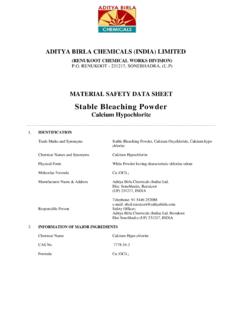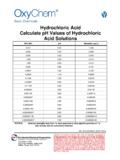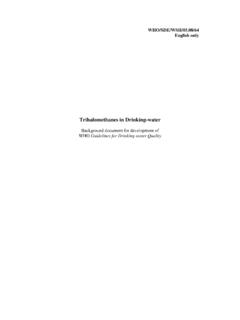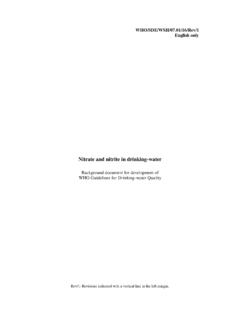Transcription of ADITYA BIRLA CHEMICALS (INDIA) LIMITED
1 ADITYA BIRLA CHEMICALS ( india ) LIMITED . (RENUKOOT chemical WORKS DIVISION). RENUKOOT - 231217, SONEBHADRA, ( ). MATERIAL SAFETY DATA SHEET. Poly Aluminium Chloride 1. IDENTIFICATION. Trade Marks and Synonyms KANPAC 18P / KANPAC-18W KANPAC 10 / KANPAC-10. MB / KANPAC 10 HB. Polyaluminium Chloride, Polyaluminium hydrochloride, chemical Name Polyaluminium hydrochloride sulphate, Polyaluminium Chloride Hydroxide, Aluminum chlorohydrate sulphate Physical Form Amber to light pale yellow, almost clear liquid Molecular Formula Aln(OH)mCl3n-m , ( Al (OH)xCly (SO4)z)n here x> , x+y+2z=3 & n-15. Manufacturer Name & Address ADITYA BIRLA CHEMICALS ( india ) Ltd, Dist.
2 Sonebhadra, Renukoot (UP) 231217, india . Telephone: 91-5446-252088. e-mail: Responsible Person Safety Officer;. ADITYA BIRLA CHEMICALS ( india ) Ltd, Renukoot Dist Sonebhadra (UP) 231217, india . 2. INFORMATION OF MAJOR INGREDIENTS. chemical Name Polyaluminium chloride liquid CAS No 1327-41-9 / 39290-78-3. Formula Aln(OH)mCl3n-m /( Al (OH)xCly (SO4)z)n Aluminum Content (%) Min. to 17 ( as Al2O3. 3. HAZARD IDENTIFICATION. Main Risk Ingestion Very astringent to mouth, nose & throat Contact with eyes Causes eye irritation Safety Phrases Keep out of reach of children. In case of contact with eye, wash immediately with plenty of water for 15-20 minutes.)
3 Seek medical aid. Remove contaminated clothes & shoes. Wash affected area with plenty of water. If inhaled, remove the victim to fresh air area & support respiration. Seek Medical Aid immediately for all types of exposure. 4. PHYSICAL AND chemical PROPERTIES. Appearance and Odour Clear or slightly opalescent, amber to light pale yellow coloured liquid with little or no odour pH (5% aqueous solution) Specific Gravity Boiling Point Appox. 120 C. Flash Point Not pertinent Melting Point About 12 C. Flammable Limit Non-flammable Vapour Pressure (mm Hg) Not applicable Solubility in Water 100 % soluble Solubility in Organic Solvents Not soluble Oxidizing /Explosive Properties None 5.
4 STABILITY AND REACTIVITY. Stability As supplied it is stable at normal temperature & pressure. Conditions to avoid Avoid contact with bases, chlorides, sulphites, hypochlorites and temperatures above 40 C. Material to avoid Long term contact with aluminum & alloys, zinc & alloys, carbon & steel Reactivity Air No reaction Water Coagulates substances suspended or dispersed in water to settle quickly to form a filterable sludge. Acids With mineral acids bulk precipitation of solid occurs Alkalis Bulk precipitation with evolution of heat occurs Hazardous Decomposition Products Hydrogen chloride 6. TOXICITY DATA. (Routes of Entry).
5 In contact with skin Irritant-after prolonged contact with skin produces sores and possible dermatitis. In contact with eyes Irritates immediately and could cause severe damage. Inhalation Product does not fumes Ingestion Very astringent to mouth, nose & throat Acute Toxicity LD50 >2000 mg/Kg Chronic Toxicity Not available 7. FIRST AID MEASURES. Skin Contact Remove contaminated clothing and wash affected area with sufficient quantity of water for 15-20 minutes. Seek medical aid Eye Contact Immediately irrigate with water for at least 15 minutes. Seek medical assistance immediately Inhalation Remove from contaminated area. Obtain medical attention.
6 Ingestion Provided patient is conscious, wash out with water. Do not induce vomiting and give 5% sodium bicarbonate solution followed by a demulcent such as milk. If in doubt, seek medical attention. 8. FIRE AND EXPLOSION HAZARD DATA. Fire Extinguishing Data Poly Aluminium chloride is non-inflammable. On burning will emit fumes. Water spray, foam, carbon dioxide or dry powder may be used. Keep containers cool with copious amounts of water. Would any material saturated No with this product be subject to spontaneous combustion? Fire Fighting Protective equipment Wear full protective clothing, goggles, masks Unusual Fire and explosive hazards In contact with metals, poly Aluminium chloride may liberate the flammable gas hydrogen 9.
7 PERSONAL PROTECTION. General Precautions Eye and skin protection should be used. Carcinogenic Toxicity No evidence Mutagenic Toxicity No evidence Throatogenic Toxicity TDLo approx 13 g/kg Respiratory Protection Not normally required Protective Clothing Protective overall, rubber gloves, hard hat, acid resistant boots. Eye Protection Goggles or full face mask 10. HANDLING AND STORAGE. Handling Avoid contact with skin, eyes, and clothing. Avoid breathing dust or mist. Keep away from metals, organic materials, nitrates, chlorates and carbides. It is compatible with lead, rubber, glass, fiber, glass, HDPE, PVC& FRP. Storage Bulk quantities should be stored in ebonite coated, steel, rubber- lined mild steel, FRP or plastic tanks.
8 For small packages, polyethylene or double skinned polyethylene containers are acceptable. Store indoors away from direct heat or sunlight. Avoid extreme temperatures. PAC may become unstable when stored for long time at temperatures higher than 40 tends to hydrolyze to a white turbid solution and loses effectiveness when it is kept long as a diluted solution of less than approximately 3%( as Al2O3). The storage area should have a non-combustible and corrosion resistant floor. 11. SPILLAGE/ACCIDENTAL RELEASE. Spillage For very small leaks wash away with large quantities of water. For other leaks collect liquid either by pumping into an emergency tank or by absorption in dry sand.
9 Personal Precautions Wear full protective clothing. Environmental Precautions Where a spillage or contaminated washing causes contamination of water courses, drains or vegetation, inform relevant authorities. 12 WASTE DISPOSAL. Waste Disposal Neutralize with lime and landfill in accordance with Local Regulations. 13. ENVIRONMENTAL INFORMATION. Environmental Fate and Distribution High tonnage material produced in wholly contained systems. Persistence and Degradation The substance is soluble in water. Unlikely to cause harmful affects, remains as chloride indefinitely. Toxicity and effect on effluent system Large discharges may contribute to the acidification of effluent treatment system and will injure organisms.
10 The product is a primary coagulant and may cause solid settlement in treatment systems. Ecological Information The product tested in various concentrations is found to be entirely harmless to aquatic life up to concentration of 200. mg/litre expressed as Al2O3 (corresponding to g/l of PAC. 10%). 14. REGULATORY INFORMATION. Danger Symbol Xi Risk Phrases R36: Irritant for eyes. R38: Irritant for skin Safety Phrases S2: Keep locked up and out of the reach of children. S7/8/9: Keep container tightly closed , dry and in a well ventilated area. S24/25: Avoid contact with skin and eyes. S26:In case of contact with eyes , rinse immediately with plenty of water and seek medical advice.








